Chams
The Chams or Cham people (Cham: Urang Campa / ꨂꨣꩃ ꨌꩌꨛꨩ,[3] Vietnamese: người Chăm or người Chàm, Khmer: ជនជាតិចាម), are an ethnic group of Austronesian origin in Southeast Asia. From the 2nd to the mid-15th century the Chams populated Champa, a contiguous territory of independent principalities in central and southern Vietnam. They spoke the Cham language and the Tsat language (the former is still spoken by the Cham and the latter is spoken by their Utsul descendants on China’s Hainan island),[4] two Chamic languages from the Malayo-Polynesian group of the Austronesian family. Chams and Malays are the only sizable Austronesian peoples that settled in Iron Age mainland Southeast Asia among the more ancient Austroasiatic inhabitants.[5]
Urang Campa / ꨂꨣꩃ ꨌꩌꨛꨩ | |
|---|---|
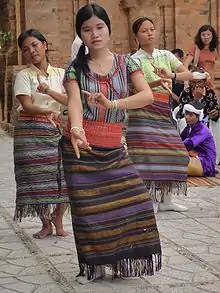 Cham women performing a traditional dance in Nha Trang, Vietnam | |
| Total population | |
| c. 800,000 | |
| Regions with significant populations | |
| 600,000[1] | |
| 178,948[2] | |
| 10,000 | |
| 8,500 | |
| 4,000 | |
| 3,000 | |
| 1,000 | |
| Languages | |
| Cham, Tsat, Vietnamese, Khmer | |
| Religion | |
| Predominantly Sunni Islam (Cambodia, Malaysia, Thailand, Southern Vietnam and Hainan, China) Minority Hinduism (Central Vietnam), Buddhism and Animism | |
| Related ethnic groups | |
| Utsul people in Hainan, China and other Austronesian peoples (especially Jarai, Rade, Acehnese) | |
History
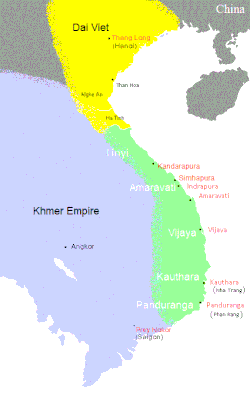
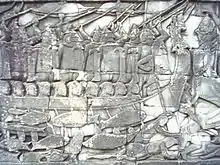
Austronesian origin, patterns and chronology of migration remain debated and it is assumed, that the Cham people arrived in peninsular Southeast Asia via Borneo.[6][7] Mainland Southeast Asia had been populated on land routes by members of the Austroasiatic language family, such as the Mon people and the Khmer people around 5,000 years ago. The Cham were accomplished Austronesian seafarers, that from 4,000 years BP populated and soon dominated maritime Southeast Asia.[8] Earliest known records of Cham presence in Indochina date back to the second century CE. Population centers around the river outlets along the coast controlled the import/export of continental Southeast Asia, therefore maritime trade was the essence of a prosperous economy.[9][10][11]
Cham folklore includes the creation of a myth in which the founder of the first Cham polity was a certain Lady Po Nagar. Coming from a humble peasant origin somewhere in the Dai An Mountains, Khánh Hòa Province, spirits assisted her as she traveled to China on a floating log of sandalwood where she married a man of royalty and had two children. She eventually returned to Champa "did many good deeds in helping the sick and the poor" and "a temple was erected in her honor".[12][13]
Early history
Like countless other political entities of Southeast Asia, the Champa principalities underwent the process of Indianization since the early common era as a result of centuries of socio-economic interaction adopted and introduced cultural and institutional elements of India. From the 8th century onward Muslims from such regions as Gujarat began to increasingly appear in trade and shipping of India. Islamic ideas became a part of the vast tide of exchange, treading the same path as Hinduism and Buddhism centuries before. Cham people picked up these ideas by the 11th century. This can be seen in the architecture of Cham temples, which shares similarities with the one of the Angkor Temples. Ad-Dimashqi writes in 1325, "the country of Champa... is inhabited by Muslims and idolaters. The Muslim religion came there during the time of Caliph Uthman... and Ali, many Muslims who were expelled by the Umayyads and by Hajjaj, fled there".
The Daoyi Zhilüe records that at Cham ports, Cham women were often married to Chinese merchants, who frequently came back to them after trading voyages.[14][15][16] A Chinese merchant from Quanzhou, Wang Yuanmao, traded extensively with Champa and married a Cham princess.[17]
In the 12th century, the Cham fought a series of wars with the Khmer Empire to the west. In 1177, the Cham and their allies launched an attack from the lake Tonlé Sap and managed to sack the Khmer capital. In 1181, however, they were defeated by the Khmer King Jayavarman VII.
Encounter with Islam
.jpg.webp)
Islam first arrived in Champa around the ninth century, however it did not become significant among the Cham people until after the eleventh century.[18]
Cham who migrated to Sulu were Orang Dampuan.[19] Champa and Sulu engaged in commerce with each other which resulted in merchant Chams settling in Sulu where they were known as Orang Dampuan from the 10th-13th centuries. The Orang Dampuan were slaughtered by envious native Sulu Buranuns due to the wealth of the Orang Dampuan.[20] The Buranun were then subjected to retaliatory slaughter by the Orang Dampuan. Harmonious commerce between Sulu and the Orang Dampuan was later restored.[21] The Yakans were descendants of the Taguima-based Orang Dampuan who came to Sulu from Champa.[19] Sulu received civilization in its Indic form from the Orang Dampuan.[22]
A number of Cham also fled across the sea to the Malay Peninsula and as early as the 15th century, a Cham colony was established in Malacca. The Chams encountered Sunni Islam there as the Malacca Sultanate was officially Muslim since 1414. The King of Champa then became an ally of the Johor Sultanate; in 1594, Champa sent its military forces to fight alongside Johor against the Portuguese occupation of Malacca.[23] Between 1607 and 1676, one of the Champa kings converted to Islam and it became a dominant feature of Cham society. The Chams also adopted the Jawi alphabet.[24]
Historical records in Indonesia showed the influence of Queen Dwarawati, a Muslim Princess from the Kingdom of Champa (Chams), toward her husband, Kertawijaya, the Seventh King of Majapahit Empire, so that the royal family of the Majapahit Empire eventually converted to Islam, which finally led to the conversion to Islam of the entire region.[25][26][27] Chams Princess tomb can be found in Trowulan, the site of the capital of the Majapahit Empire.[28] In Babad Tanah Jawi, it is said that the king of Brawijaya V has a wife named Dewi Anarawati (or Dewi Dwarawati), a Muslim daughter of the King of Champa (Chams).[25][26][27] Chams had trade and close cultural ties with the maritime kingdom of Srivijaya, and Majapahit then in the Malay Archipelago.
Another significant figure from Champa in the history of Islam in Indonesia is Raden Rakhmat (Prince Rahmat) who's also known as Sunan Ampel, one of Wali Sanga (Nine Saints), who spread Islam in Java. He is considered as a focal point of the Wali Sanga, because several of them were actually his descendants and/or his students. His father is Maulana Malik Ibrahim also known as Ibrahim as-Samarkandy ("Ibrahim Asmarakandi" to Javanese ears), and his mother is Dewi Candrawulan, a princess of Champa (Chams) who's also the sister of Queen Dwarawati. Sunan Ampel was born in Champa in 1401 CE. He came to Java in 1443 CE, in order to visit his aunt Queen Dwarawati, a princess of Champa who married to Kertawijaya (Brawijaya V), the King of Majapahit Empire.[25][26][27] Local legend says that he built the Great Mosque of Demak (Masjid Agung Demak) in 1479 CE, but other legends attribute that work to Sunan Kalijaga. Sunan Ampel died in Demak in 1481 CE, but is buried in Ampel Mosque at Surabaya, East Java.[29]
Wars with Vietnam
Between the rise of the Khmer Empire around 800 and the Vietnamese people's territorial push south from Jiaozhi and, later, Đại Việt, Champa began to shrink. At a disadvantage against Vietnam's army of 300,000 troops, the Chams 100,000 were no match.[30] In the Cham–Vietnamese War (1471), Champa suffered serious defeats at the hands of the Vietnamese, in which 120,000 people were either captured or killed, and the kingdom was reduced to a small enclave near Nha Trang with many Chams fleeing to Cambodia.[31][23] Champa was no longer a threat to Vietnam, and some were even enslaved by their victors.[32]
The Cham were matrilineal and inheritance passed through the mother.[33] Because of this, in 1499 the Vietnamese enacted a law banning marriage between Cham women and Vietnamese men, regardless of class.[34](Tạ 1988, p. 137)[35][36][37] The Vietnamese also issued instructions in the capital to kill all Chams within the vicinity.[38] More attacks by the Vietnamese continued and in 1693 the Champa Kingdom's territory was integrated as part of Vietnamese territory.[39]
The trade in Vietnamese ceramics was damaged due to the plummet in trade by Cham merchants after the 1471 Vietnamese invasion of Champa.[40] Vietnam's export of ceramics was also damaged by its internal civil war, the Portuguese and Spanish entry into the region and the Portuguese conquest of Malacca which caused an upset in the trading system, while the carracks ships in the Malacca to Macao trade run by the Portuguese docked at Brunei due to good relations between the Portuguese and Brunei after the Chinese permitted Macao to be leased to the Portuguese.[41]
When the Ming dynasty in China fell, several thousand Chinese refugees fled south and extensively settled on Cham lands and in Cambodia.[42] Most of these Chinese were young males, and they took Cham women as wives. Their children identified more with Chinese culture. This migration occurred in the 17th and 18th centuries.[43]
Chams participated in defeating the Spanish invasion of Cambodia. Cambodian king Cau Bana Cand Ramadhipati, also known als 'Sultan Ibrahim', launched the Cambodian–Dutch War to expel the Dutch. The Vietnamese Nguyen Lords toppled Ibrahim from power to restore Buddhist rule.
In the 1700s and 1800s Cambodian based Chams settled in Bangkok.[44]
Fall of the Champa kingdom
Further expansion by the Vietnamese in 1720 resulted in the total annexation of the Champa kingdom and dissolution by the 19th century Vietnamese Emperor, Minh Mạng. In response, the last Champa Muslim king, Pô Chien, gathered his people in the hinterland and fled south to Cambodia, while those along the coast migrated to Trengganu (Malaysia). A small group fled northward to the Chinese island of Hainan where they are known today as the Utsuls. Their refuge in Cambodia where the king and his people settled and were scattered in communities across the Mekong Basin. Those who remained in the Nha Trang, Phan Rang, Phan Rí, and Phan Thiết provinces of central Vietnam were absorbed into the Vietnamese polity. Cham provinces were seized by the Nguyen Lords.[45]
After Vietnam invaded and conquered Champa, Cambodia granted refuge to Cham Muslims escaping from Vietnamese conquest.[46]
In 1832 the Vietnamese Emperor Minh Mang annexed the last Champa Kingdom. This resulted in the Cham Muslim leader Katip Suma, who was educated in Kelantan, declaring a Jihad against the Vietnamese.[47][48][49][50] The Vietnamese coercively fed lizard and pig meat to Cham Muslims and cow meat to Cham Hindus against their will to punish them and assimilate them to Vietnamese culture.[51]
20th century
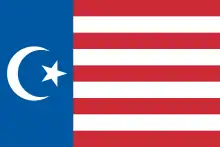
In the 1960s various movements emerged calling for the creation of a separate Cham state in Vietnam. The Liberation Front of Champa (FLC – Le Front pour la Libération de Cham) and the Front de Libération des Hauts plateaux dominated. The latter group sought greater alliance with other hill tribe minorities. Initially known as "Front des Petits Peuples" from 1946 to 1960, the group later took the designation "Front de Libération des Hauts plateaux" and joined, with the FLC, the "Front unifié pour la Libération des Races opprimées" (FULRO) at some point in the 1960s. Since the late 1970s, there has been no serious Cham secessionist movement or political activity in Vietnam or Cambodia.
During the Vietnam War, a sizable number of Chams migrated to Peninsular Malaysia, where they were granted sanctuary by the Malaysian government out of sympathy for fellow Muslims; most of them have now assimilated with Malay cultures.[39]
The Cham community suffered a major blow during the Khmer Rouge rule of Cambodia. The Khmer Rouge targeted ethnic minorities like Chinese, Thai, Lao, Vietnamese and Cham people, though the Cham suffered the largest death toll in proportion to their population. Around 100,000 to 500,000 Cham out of a total Cham population of 250,000 to 650,000 died in the genocide.[52][53]
21st century
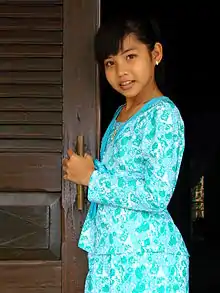
National Geographic article
In a National Geographic article in June 2014,[54][55][56] the journalist Adam Bray claimed that the Vietnamese government feared that evidence of Champa's influence over the disputed area in the South China Sea would bring international attention to human rights violations and killings of ethnic minorities in Vietnam. These events were said to have occurred in the 2001 and 2004 uprisings, leading to the issue of Cham autonomy being brought into the dispute. The Vietnamese conquered Cham people in a war in 1832, and Bray claims the Vietnamese are destroying all evidence of Cham culture and artifact, desecrating Cham temples, and establishing buildings and farms over religious sites. Bray claimed further that the Vietnamese had banned Cham religious practices, and had deleted references (in history books and tourist guides) to the Cham capital of Song Luy, destroyed in the 1832 invasion. Compared to ethnic Vietnamese, the living conditions of Cham are said to be far worse, as they lack water and electricity and have to live in mud houses.
Mistreatment of the Cham
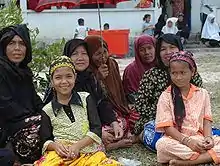
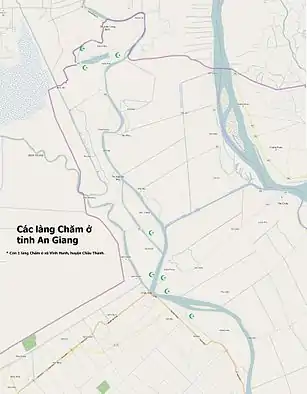
The Cham in Vietnam are officially recognized by the Vietnamese government as one of 54 ethnic groups. However, according to the Cham advocacy group International Office of Champa (IOC-Champa) and Cham Muslim activist Khaleelah Porome, both Hindu and Muslim Chams have experienced religious and ethnic persecution and restrictions on their faith under the current Vietnamese government, with the Vietnamese state confisticating Cham property and forbidding Cham from observing their religious beliefs. Hindu temples were turned into tourist sites against the wishes of the Cham Hindus. In 2010 and 2013 several incidents occurred in Thành Tín and Phươc Nhơn villages where Cham were murdered by Vietnamese. In 2012, Vietnamese police in Chau Giang village stormed into a Cham Mosque, stealing the electric generator.[57] Cham Muslims in the Mekong Delta have also been economically marginalized, with ethnic Vietnamese settling (with state support) on land previously owned by Cham people.[58]
A Cambodian Cham Muslim dissident, Hassan A Kasem, a former military helicopter pilot who was both persecuted and imprisoned by the Khmer Rouge and fought against Vietnamese invasion, denounced Vietnam as trying to position itself as the savior of Cambodia from Khmer Rouge rule and wrote that Vietnam has deceived the west into thinking of it as a "magnanimous liberator" when it invaded Cambodia and ousted the Khmer Rouge when in fact Vietnam used the war to benefit its own interests such subjecting Cambodian financial assets and national treasures to pillaging and theft, settling border disputes to its own advantage, trying to destroy Cambodian nationalist feeling against Vietnam, benefiting from the mostly Khmer on Khmer violence by the Khmer Rouge and setting up its own Communist puppet government to rule Cambodia, the Cambodia People's Party (CPP) with Vietnamese soldiers secretly remaining behind in Cambodia to prop up the puppet government and Vietnamese officials pretending to be Khmer continuing to direct the government as their puppet.[59] The Cham activist organisation "International Office of Champa" republished Hassan's article on their website Cham Today.[60]
An attempt at Salafist expansion among the Cham in Vietnam has been halted by Vietnamese government controls, however, the loss of the Salafis among Chams has been to be benefit of Tablighi Jamaat.[61]
The Muslim Acehnese people of Aceh, Sumatra, Indonesia, are the descendants of Cham refugees who fled after defeat by the Vietnamese polity in the 15th century.[3][62]
Geography
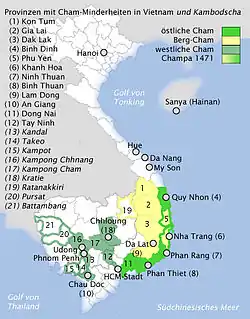
Cham people represent the core of the Muslim communities in both Cambodia and Vietnam. Their contemporary population is concentrated between the Kampong Cham Province in Cambodia and Phan Rang–Tháp Chàm, Phan Thiết, Ho Chi Minh City and An Giang Province in Southern Vietnam. Including the diaspora, their total is about 400,000. An additional 4,000 Chams live in Bangkok, Thailand, whose ancestors migrated there during Rama I's reign. Recent immigrants to Thailand are mainly students and workers, who preferably seek work and education in the southern Islamic Pattani, Narathiwat, Yala and Songkhla provinces.[63][64][65]
After the fall of Saigon in Vietnam and Phnom Penh in Cambodia in 1975, 9,704 Cham refugees made their way to Malaysia and were allowed to stay, unlike 250,000 other refugees that fled to Malaysia. Most of the Cham refugees came from Cambodia and were Muslims, known as Melayu Kemboja and Melayu Champa in Malay. Many of these Cham refugees chose to settle in Malaysia, as they preferred to live in an Islamic country and had family ties in the Malaysian states of Kelantan and Terengganu. Kelantan served as a center of Islamic teachings for Chams in Cambodia for three to four centuries and many Cambodian Chams had relatives living there, subsequently many Chams chose to settle in Kelantan. By 1985, around 50,000 or more Chams were living in Malaysia. As of 2013, many have been integrated into Malaysian society.[66]
Politics
While historically complicated, the modern Chams of Cambodia and Vietnam have had friendly relationships with the Khmer and Vietnamese majority. Despite ethnic and religious differences, the majority people of Cambodia and Vietnam have accepted the Cham as closer to them than other minorities.[18] Some Muslim Cham report a friendly attitude of both Cambodians and Vietnamese toward the Chams and little harassment against them from locals.[67] However, between government and people, it is difficult to categorize. According to Cham human rights activists, the Vietnamese regime, the fears of historical influence has evolved into suppression of Islam among Muslims Chams. For example there is an unofficial ban on distributing the Quran and other Islamic scripture.[68] Meanwhile, due to Vietnam's growing relations with Muslim states like Indonesia, Malaysia, Saudi Arabia, Iran, Turkey and Egypt, the regime discourages growth of Islam because the Vietnamese government distrusts the Cham Muslims.[69]
"Relations between the Hanoi government and ethnic minorities are sensitive. In 2001 and 2004 massive human rights protests by hill tribes resulted in deaths and mass imprisonments. For some time after that, the Central Highlands were sealed off to foreigners."
The Vietnamese Muslim Association is the official association representing Muslim interests, including the Chams, in the country. The Cambodian Islamic Association is the official representation of Cambodian Muslims of Cham ethnicity. The Hindus are also represented from various Cham and Indian organizations across both countries.
Culture
The Cham culture is diverse and rich because of the combination of indigenous cultural elements (plains culture, maritime culture, and mountain culture) and foreign cultural features (Indian cultures and religions such as Buddhism; early Han Chinese influences; Islam) (Phan Xuan Bien et al. 1991:376). The blend of indigenous and foreign elements in Cham culture is a result of ecological, social, and historical conditions. The influences of various Indian cultures produced similarities among many groups in Southeast Asia such as the Cham, who traded or communicated with polities on the Indian subcontinent. However, the indigenous elements also allow for cultural distinctions. As an example, Brahmanism became the Ahier religion, while other aspects of influence were changed, to adapt to local Ahier characteristics and environment. The blending of various cultures has produced its own unique form through the prolific production of sculptures and architecture only seen at the Champa temple tower sites. The Champa temples provide a wealth of information about Cham history, art, and construction techniques, through analysis and interpretation of architecture, styles, and inscriptions.
The Cham shielded and always observed their girls attentively, placing great importance on their virginity. A Cham saying said "As well leave a man alone with a girl, as an elephant in a field of sugarcane."[71]
The Cham Muslims view the karoeh (also spelled karoh) ceremony for girls as very significant. This symbolic ceremony marks the passage of a girl from infancy to puberty (the marriageable age), and usually takes place when the girl is aged fifteen and has completed her development.[72] If it has not taken place, the girl cannot marry since she is "tabung". After the ceremony is done the girl can marry. Circumcision to the Cham was less significant than karoeh.[73] It is not practiced, only symbolic and performed with a toy wooden knife.
Important festivals include Kate, celebrated mainly by the Cham of central Vietnam. The festival venerates ancient Cham royalty gods. Among Cham Muslims, Ramadan, El Fitri, and the Hajj are important celebrations. However, the Cham (regardless of faith) all have a very rich tradition of dance, arts, music, costumes, poetry, and more.
Language
The Cham language is part of the Austronesian language family. Cham is very rich with many loan words and terminology influenced by many other languages it came into contact with. Most Cham speak the language though many also speak the dominant language of the nation they reside in like Vietnamese, Khmer, Malay and others. Some Cham can also speak and write Arabic.[18]
Cham is written in Cham script in Central Vietnam while the language is written in Arabic script around the Mekong Delta.[18]
Religion
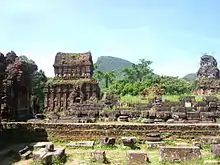
The first recorded religion of the Champa was a form of Shaiva Hinduism, brought by sea from India. Hinduism was the predominant religion among the Cham people until the sixteenth century. Numerous temples dedicated to Shiva were constructed in the central part of what is now Vietnam. The jewel of such temple is Mỹ Sơn. It is often compared with other historical temple complexes in Southeast Asia, such as Borobudur of Java in Indonesia, Angkor Wat of Cambodia, Bagan of Myanmar and Ayutthaya of Thailand. As of 1999, Mỹ Sơn has been recognised by UNESCO as a world heritage site.
Religiously and culturally, the Chams were grouped into two major religio-cultural groups; the Balamon Chams that adhere to an indigenized form of Hinduism, and Bani Chams that adhere to an indigenized form of Islam. The term "Balamon" derived from "Brahman" or "Brahmin", one of Hindu caste of religious elite. The term "Bani" on the other hand is derived from Arabic term "bani" (بني) which means "people". Balamon Chams adhere to the old religion of their ancestor, an indigenized form of Hinduism that thrived since the ancient era of Kingdom of Champa in 5th century CE, whereas Bani Chams are Muslims that converted to Islam as early as around the 11th–13th century. However, it was not until 17th century that Islam began to attract large numbers of Chams, when some members of the Cham royalty converted to Islam. These two groups mostly live in separate villages. Intermarriage was prohibited in former times, and remains rare even nowadays. Both groups are matrilineal and conform to matrilocal residence practice.[74]
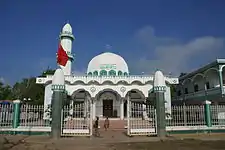
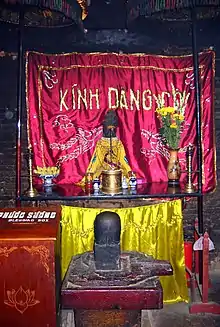
As Muslim merchants of Arab and of Persian origin stopped along the Vietnam coast en route to China, Islam began to influence Cham civilization. The exact date that Islam came to Champa is unknown; however, the religion first arrived around the ninth century.[18] It is generally assumed that Islam came to mainland Southeast Asia much later than its arrival in China during the Tang dynasty (618–907) and that Arab traders in the region came into direct contact only with the Cham and not others. Islam began making headway among the Chams beginning in the eleventh century. The version of Islam practiced by the Vietmamese Chams in Central Vietnam is often called Bani which contains many pre-Islamic beliefs and rituals such as magic, spirit worship, and propitiation of the souls of former kings, something mistaken to Hinduism. Cambodian and Southern Vietnamese Muslim Chams practice Sunni Islam though it has many indigenous, magical and Buddhist elements to it; while some practice a more centralized form of Sunni Islam and even radical Salafist Islam can also be found.[18]
A syncretic form of Islam that blends indigenous practices of matriarchy, ancestor veneration and Hinduism is practiced by the Cham Bani, who predominantly live in Vietnam's Bình Thuận and Ninh Thuận Provinces.[75] The Cham Bani worship in thang magik, the main communal setting for rituals.[75] They also celebrate the month of Ramuwan (Ramadan), during which ancestors are called to return home for veneration, and the acar (priests) stay at the thang magik for one month and adhere to a vegetarian diet.[75]
However, a small band of Chams, who called themselves Kaum Jumaat, follow a localized adaptation of Islamic theology, according to which they pray only on Fridays and celebrate Ramadan for only three days. However, some members of this group have joined the larger Muslim Cham community in their practices of Islam in recent years. One of the factors for this change is the influence by members of their family who have gone abroad to study Islam.
Numbers
The approximately 60,000 Cham Hindus, called Balamon Cham or Balamon Hindu,[76] do not have a strict caste system, although previously they may have been divided between the Nagavamshi Kshatriya[77] and the Brahmin castes, the latter of which would have represented a small minority of the population.[78] Hindu temples are known as Bimong in Cham language, but are commonly referred to as tháp "stupa", in Vietnamese. The priests are divided into three levels, where the highest rank are known as Po Adhia or Po Sá, followed by Po Tapáh and the junior priests Po Paséh. In Ninh Thuận, where many of the Cham in Vietnam reside, Cham Balamon (Hindu Cham) number 44,000 while Cham Bani (Muslim Cham) number close to 31,000. Out of the 34 Cham villages in Ninh Thuận, 23 are Balamon Hindu, while 11 are Bani or Muslim.[79] In Binh Thuan province, Balamon number close to 25,000 and Bani Cham around 10,000. There are four pure Cham villages and nine mixed villages in Bình Thuận Province.[80] The Hinduism practiced by these Cham also has many elements of indigneous beliefs like the inclusion of Po Inu Nagar, a mother goddess figure.[18]
The majority of Chams in Vietnam (also known as the Eastern Chams) are Hindu mostly live in Central Vietnam, while Southern Vietnam's Chams and their Cambodian counterparts are largely Muslim, as Islamic conversion happened relatively late.[81][82] A smaller number of the Eastern Cham also follow Mahayana Buddhism. A number emigrated to France in the late 1960s during the Vietnam War.
Notable Chams
- Les Kosem : Cambodian-Cham activist leader in FULRO
- Po Dharma : Vietnamese-Cham activist leader of FULRO, he was also a Cham cultural historian
- Sos Math : Cambodian-Cham singer, songwriter from the 1950s to the 1970s ; his son Sos Mach is also a popular singer from the 90's still today
- Has Salan : one of the most famous Cambodian classical violinist, composer from the 1950s to 1970s, also appared in several movies ; he was from Cham ethnic
- Musa Porome : Cham rights activist
- P'an-Lo T'ou-Ts'iuan
- Amu Nhan : expert on Cham music
- Chế Bồng Nga : the last strong king of Champa
- Ahmad Tony : Cham Extreme Razor Scooter Champion
- Chế Linh : Vietnamese-Cham singer
- Dang Nang Tho : sculptor and director of Cham Cultural Center, Phan Rang, Ninh Thuan Province
- Inrasara (Mr Phu Tram) : poet & author
- Osman Hasan : Cambodian-Cham politician, secretary of state at the Ministry of Labor and Vocational Training of Cambodia
- Nos Sles : Cambodian-Cham politician, secretary of state at the Ministry of Education and Sport of Cambodia
- Amath Yashya : Cambodian-Cham politician in the National Assembly of Cambodia since 2003
Data tables
| Admixture analysis of the two populations from southern Vietnam. | ||
|---|---|---|
| Admixed populations | Parental populations | |
| MSEA1 (n = 890) | WISEA2 (n = 983) | |
| Cham (n = 59) | 0.62405¶ 0.629437 ± 0.256634† | 0.37595 0.370563 ± 0.256634 |
| Vietnamese (n = 70) | 0.842972 0.839953 ± 0.56035 | 0.157028 0.160047 ± 0.56035 |
| Note: ¶ admixture coefficient; † bootstrap average and standard deviation of the admixture coefficient were obtained by bootstrap with 1000 replications. 1 MSEA: Mainland Southeast Asia 2 WISEA: western island Southeast Asia | ||
| Source: Table 2, Page 7, He Jun-dong et al. (2012)[83] | ||
See also
References
- Leonie Kijewski (13 December 2019). "'Beautifying Phnom Penh': Muslim Cham face eviction in Cambodia". Al Jazeera. Retrieved 22 December 2019.
- "Report on Results of the 2019 Census". General Statistics Office of Vietnam. Retrieved 1 May 2020.
- Andaya, Leonard Y. (2008). Leaves of the same tree: trade and ethnicity in the Straits of Melaka. University of Hawaii Press. p. 44. ISBN 978-0-8248-3189-9.
- Utsat in China
- Brown, Rajeswary Ampalavanar (1 October 2013). Islam in Modern Thailand: Faith, Philanthropy and Politics - Rajeswary Ampalavanar Brown - Google Books. Google Books. ISBN 9781134583898. Retrieved 26 January 2017.
- "Origins and diversification: the case of Austroasiatic groups" (PDF). Rogerblench.info. Retrieved 25 January 2017.
- Anne-Valérie Schweyer Le Viêtnam ancien (Les Belles Lettres, 2005) p.6
- "Genetic ancestry highly correlated with ethnic and linguistic groups in Asia". eurekalert. Retrieved 25 January 2017.
- "The Cham People - Cambodian Village Scholars Fund". cambodianscholars.org. Archived from the original on 2 February 2017. Retrieved 27 January 2017.
- "THE AUSTRONESIAN SETTLEMENT OF MAINLAND SOUTHEAST ASIA" (PDF). Sealang. Retrieved 2 January 2017.
- Lipson, Mark; Loh, Po-Ru; Patterson, Nick; Moorjani, Priya; Ko, Ying-Chin; Stoneking, Mark; Berger, Bonnie; Reich, David (19 August 2014). "Reconstructing Austronesian population history in Island Southeast Asia". Nature Communications. 5 (1): 4689. Bibcode:2014NatCo...5.4689L. doi:10.1038/ncomms5689. PMC 4143916. PMID 25137359.
- Chapuis 1995, p. 39.
- "Vietnamese History & Legends". Vietspring.org. Archived from the original on 29 November 2010. Retrieved 25 January 2017.
- Derek Heng (15 November 2009). Sino–Malay Trade and Diplomacy from the Tenth through the Fourteenth Century. Ohio University Press. pp. 133–. ISBN 978-0-89680-475-3.
- Heng 2009, p. 133.
- http://zh.wikisource.org/zh-hant/島夷誌略#.E5.8D.A0.E5.9F.8E
- Wicks 1992, p. 215.
- Skutsch, Carl, ed. (2005). Encyclopedia of the World's Minorities. New York: Routledge. pp. 276, 277. ISBN 1-57958-468-3.
- Maria Christine N. Halili (2004). Philippine History. Rex Bookstore. pp. 46ff. ISBN 978-9712339349.
- The Filipino Moving Onward 5' 2007 Ed. Rex Bookstore, Inc. pp. 3–. ISBN 978-971-23-4154-0.
- Philippine History Module-based Learning I' 2002 Ed. Rex Bookstore, Inc. pp. 39–. ISBN 978-971-23-3449-8.
- Study Skills in English for a Changing World' 2001 Ed. Rex Bookstore, Inc. pp. 23–. ISBN 978-971-23-3225-8.
- Schliesinger 2015, p. 18.
- Davidson 1991, p. 105.
- Philip Taylor (2007). Cham Muslims of the Mekong Delta: place and mobility in the cosmopolitan periphery. NUS Press. p. 78. ISBN 978-9971-69-361-9. Retrieved 9 January 2011.
- Agus Sunyoto (2014). Atlas Wali Songo (The Atlas of Nine Saint). Mizan. ISBN 978-602-8648-09-7. Archived from the original on 4 March 2016. Retrieved 14 January 2016.
- John Renard (2009). Tales of God's Friends: Islamic Hagiography in Translation. University of California Press. p. 343. ISBN 9780520258969. Retrieved 17 January 2016.
- Slamet Muljana (2005). Runtuhnya kerajaan Hindu-Jawa dan timbulnya negara-negara Islam di Nusantara. PT LKiS Pelangi Aksara. p. 68. ISBN 978-979-8451-16-4. Retrieved 9 January 2011.
- id:Sunan Ampel
- Oscar Chapuis (1995). A history of Vietnam: from Hong Bang to Tu Duc. Greenwood Publishing Group. p. 46. ISBN 0-313-29622-7. Retrieved 9 January 2011.
- Roof 2011, p. 1210.
- Ben Kiernan (2009). Blood and Soil: A World History of Genocide and Extermination from Sparta to Darfur. Yale University Press. p. 110. ISBN 0-300-14425-3. Retrieved 9 January 2011.
- Hooker 2002, p. 75.
- Kiernan 2008, p. 111.
- Watson Andaya 2006, p. 82.
- Yale University, Southeast Asia Studies (1985). The Vietnam forum, Issues 5-7. Council on Southeast Asia Studies at Yale University. p. 28. Retrieved 9 January 2011.
- Teresa A. Meade, Merry E. Wiesner-Hanks (2006). A companion to gender history. Wiley-Blackwell. p. 332. ISBN 978-1-4051-4960-0. Retrieved 9 January 2011.
- Victor B. Lieberman (2003). Strange parallels: Southeast Asia in global context, c 800-1830, Volume 1 (illustrated ed.). Cambridge University Press. p. 381. ISBN 978-0-521-80496-7. Retrieved 15 May 2011.
- Juergensmeyer & Roof 2011, p. 1210.
- Angela Schottenhammer; Roderich Ptak (2006). The Perception of Maritime Space in Traditional Chinese Sources. Otto Harrassowitz Verlag. pp. 138–. ISBN 978-3-447-05340-2.
- Minh Trí Bùi; Kerry Nguyễn Long (2001). Vietnamese Blue & White Ceramics. Khoa học xã hội. p. 176.
- Encyclopædia Britannica, inc (2003). The New Encyclopædia Britannica, Volume 8. Encyclopædia Britannica. p. 669. ISBN 978-0-85229-961-6. Retrieved 28 June 2010.
- Barbara Watson Andaya (2006). The flaming womb: repositioning women in early modern Southeast Asia. University of Hawaii Press. p. 146. ISBN 978-0-8248-2955-1. Retrieved 28 June 2010.
southern vietnam thousands of young chinese males brides cham communities.
- Rajeswary Ampalavanar Brown (1 October 2013). Islam in Modern Thailand: Faith, Philanthropy and Politics. Routledge. pp. 19–. ISBN 978-1-134-58389-8.
- Elijah Coleman Bridgman; Samuel Wells Willaims (1847). The Chinese Repository. proprietors. pp. 584–.
- Dr. Mark Phoeun. "PO CEI BREI FLED TO CAMBODIA IN 1795-1796 TO FIND SUPPORT". Cham Today. Translated by Musa Porome. IOC-Champa. Archived from the original on 2006.
- Jean-François Hubert (8 May 2012). The Art of Champa. Parkstone International. pp. 25–. ISBN 978-1-78042-964-9.
- "The Raja Praong Ritual: A Memory of the Sea in Cham- Malay Relations". Cham Unesco. Archived from the original on 6 February 2015. Retrieved 25 June 2015.
- (Extracted from Truong Van Mon, "The Raja Praong Ritual: a Memory of the sea in Cham- Malay Relations", in Memory And Knowledge of the Sea in South Asia, Institute of Ocean and Earth Sciences, University of Malaya, Monograph Series 3, pp, 97-111. International Seminar on Maritime Culture and Geopolitics & Workshop on Bajau Laut Music and Dance", Institute of Ocean and Earth Sciences and the Faculty of Arts and Social Sciences, University of Malaya, 23-24/2008)
- Dharma, Po. "The Uprisings of Katip Sumat and Ja Thak Wa (1833-1835)". Cham Today. Archived from the original on 26 June 2015. Retrieved 25 June 2015.
- Choi Byung Wook (2004). Southern Vietnam Under the Reign of Minh Mạng (1820-1841): Central Policies and Local Response. SEAP Publications. pp. 141–. ISBN 978-0-87727-138-3.
- Gellately, Robert; Kiernan, Ben (7 July 2003). The Specter of Genocide: Mass Murder in Historical Perspective - Google Boeken. ISBN 9780521527507. Retrieved 17 June 2014.
- Bray, Adam (16 June 2014). "The Cham: Descendants of Ancient Rulers of South China Sea Watch Maritime Dispute From Sidelines". National Geographic News. Retrieved 3 September 2014.
- Note: The Cham activist organization "International Office of Champa" republished Bray's article on their website Cham Today.
- Bray, Adam. "The Cham: Descendants of Ancient Rulers of South China Sea Watch Maritime Dispute From Sidelines". IOC-Champa. Archived from the original on 26 June 2015.
- "Mission to Vietnam Advocacy Day (Vietnamese-American Meet up 2013) in the U.S. Capitol. A UPR report By IOC-Campa". Chamtoday.com. 14 September 2013. Archived from the original on 22 February 2014. Retrieved 17 June 2014.
- Taylor, Philip (December 2006). "Economy in Motion: Cham Muslim Traders in the Mekong Delta" (PDF). The Asia Pacific Journal of Anthropology. The Australian National University. 7 (3): 238. doi:10.1080/14442210600965174. ISSN 1444-2213. S2CID 43522886. Archived from the original (PDF) on 23 September 2015. Retrieved 3 September 2014.
- Kasem, Hassan A (9 October 2013). "Vietnam's hidden hand in Cambodia's impasse". Asia Times Online.
- Kasem, Hassan A. "Vietnam's hidden hand in Cambodia's impasse". IOC-Champa. Archived from the original on 30 June 2015.
- Féo, Agnès De. "Les musulmans de Châu Đốc (Vietnam) à l'épreuve du salafisme". Recherches en Sciences Sociales Sur l'Asie du Sud-Est. moussons: 359–372.
- Reid, Anthony (2006). Verandah of violence: the background to the Aceh problem. NUS Press. p. 8. ISBN 978-9971-69-331-2.
- "Thailand's World : Cham People Thailand". Thailandsworld.com. Archived from the original on 19 June 2017. Retrieved 26 January 2017.
- "MISSIONS ATLAS PROJECT SOUTHEAST ASIA CAMBODIA" (PDF). Worldmap.org. Archived from the original (PDF) on 12 May 2013. Retrieved 25 January 2017.
- "Cham students caught up in Thailand's troubled south, National, Phnom Penh Post". Phnompenhpost.com. Retrieved 26 January 2017.
- Wong, Danny, Tze Ken (2013). "The Cham Arrivals in Malaysia: Distant Memories and Rekindled Links". Cite journal requires
|journal=(help) - https://themuslimvibe.com/western-muslim-culture/meet-the-vietnamese-muslims-in-hanoi
- https://mvslim.com/isolated-muslim-communities-know-cham-muslims-vietnam-simone-donvang/
- Willoughby, J. (1999). "The Cham Muslims of Vietnam". ISIM Newsletter. 2 (1): 14. hdl:1887/17164.
- https://news.nationalgeographic.com/news/2014/06/140616-south-china-sea-vietnam-china-cambodia-champa/
- (the University of Michigan)Alan Houghton Brodrick (1942). Little China: the Annamese lands. Oxford university press. p. 264. Retrieved 28 November 2011.
The Cham women have a high reputation for chastity, and, at any rate, they are closely watched and guarded. 'As well leave a man alone with a girl,' runs their proverb, 'as an elephant in a field of sugarcane.' There are, indeed, traces of matriarchate in the Cham customs, and women play an important part in their religious life. At her first menstruation a Cham girl goes into the
- Special Operations Research Office. "Selected Groups in the Republic of Vietnam - The Cham". Naval History and Heritage Command. Retrieved 30 September 2016.
- (the University of Michigan)Henri Parmentier; Paul Mus; Etienne Aymonier (2001). Cham sculpture of the Tourane Museum, Da Nang, Vietnam: religious ceremonies and superstitions of Champa. White Lotus Press. p. 52. ISBN 978-974-7534-70-2. Retrieved 28 November 2011.
A much more important ceremony than circumcision is celebrated by these Muslim Cham when their daughters reach the age of about fifteen. It is called karoeh ( closing, closure). Until her karoeh has taken place, a girl is tabung, and cannot think of marriage or its equivalent.
- Phuong, Tran Ky; Lockhart, Bruce (1 January 2011). The Cham of Vietnam: History, Society and Art. NUS Press. ISBN 978-9971-69-459-3.
- Yoshimoto, Yasuko (December 2012). "A Study of the Hồi giáo Religion in Vietnam: With a Reference to Islamic Religious Practices of Cham Bani" (PDF). Southeast Asian Studies. Kyoto: Center for Southeast Asian Studies, Kyoto University. 1 (3).
- "The Cham: Descendants of Ancient Rulers of South China Sea Watch Maritime Dispute From Sidelines". National Geographic News. 18 June 2014.
- India's interaction with Southeast Asia, Volume 1, Part 3 By Govind Chandra Pande, Project of History of Indian Science, Philosophy, and Culture, Centre for Studies in Civilizations (Delhi, India) p.231,252
- "Vietnam". State.gov. 22 October 2002. Retrieved 17 June 2014.
- Interview with High Priest or Po Adhia of Ninh Thuan province and his assistant, 23 December 2011
- Interview with priest or Po Guru near Ma Lam town, and the director of Binh Thuan Cham Cultural Center, Bac Binh district, 22 December 2011
- "Cham - Introduction, Location, Language, Folklore, Religion, Major holidays, Rites of passage, Relationships, Living conditions". Everyculture.com. Retrieved 17 June 2014.
- The Garland handbook of Southeast Asian music By Terry E. Miller, Sean Williams. p. 326
- He, Jun-Dong; Peng, Min-Sheng; Quang, Huy Ho; Dang, Khoa Pham; Trieu, An Vu; Wu, Shi-Fang; Jin, Jie-Qiong; Murphy, Robert W.; Yao, Yong-Gang; Zhang, Ya-Ping (7 May 2012). Kayser, Manfred (ed.). "Patrilineal Perspective on the Austronesian Diffusion in Mainland Southeast Asia". PLOS ONE. 7 (5): e36437. Bibcode:2012PLoSO...736437H. doi:10.1371/journal.pone.0036437. PMC 3346718. PMID 22586471.
Bibliography
- Aymonier, Étienne (1891). Les Tchames et leurs religions. E. Leroux.
- Cabaton, Antoine (1901). Nouvelles recherches sur les Chams. E. Leroux.
- Hourani, George; Carswell, John (1995). Arab Seafaring in the Indian Ocean in Ancient and Early Medieval Times. Princeton University Press. ISBN 978-0-691-00032-9.
- Chapuis, Oscar (1995). A History of Vietnam: From Hong Bang to Tu Duc. Greenwood Press. ISBN 978-0-313-29622-2.
- Davidson, Jeremy H. C. S. (1991). Austroasiatic Languages: Essays in Honour of H.L. Shorto. Psychology Press. ISBN 978-0-7286-0183-3.
- Heng, Derek (2009). Sino–Malay Trade and Diplomacy from the Tenth through the Fourteenth Century. Ohio University Press. ISBN 978-0-89680-475-3.
- Hooker, M. B. (1 January 2002). Law and the Chinese in Southeast Asia. Institute of Southeast Asian Studies. ISBN 978-981-230-125-3.
- Juergensmeyer, Mark; Roof, Wade Clark (2011). Encyclopedia of Global Religion. SAGE Publications. ISBN 978-1-4522-6656-5.
- Kiernan, Ben (1 October 2008). Blood and Soil. Yale University Press. ISBN 978-0-300-13793-4.
- Schliesinger, Joachim (11 January 2015). Ethnic Groups of Cambodia Vol 3: Profile of Austro-Thai and Sinitic-Speaking Peoples. Booksmango. ISBN 978-1-63323-240-2.
- Tạ, Văn Tài (1988). The Vietnamese Tradition of Human Rights. Institute of East Asian Studies, University of California. ISBN 978-1-55729-002-1.
- Tarling, Nicholas (1999). The Cambridge History of Southeast Asia. Cambridge University Press. ISBN 978-0-521-66370-0.
- Taylor, Philip (2007). Cham Muslims of the Mekong Delta: Place and Mobility in the Cosmopolitan Periphery. NUS Press. ISBN 978-9971-69-361-9.
- Watson Andaya, Barbara (2006). The Flaming Womb: Repositioning Women in Early Modern Southeast Asia. University of Hawaii Press. p. 82. ISBN 978-0-8248-2955-1.
- Wicks, Robert S. (1992). Money, Markets, and Trade in Early Southeast Asia: The Development of Indigenous Monetary Systems to AD 1400. SEAP Publications. ISBN 978-0-87727-710-1.
- Dổ Hải Minh (1965) "Dân Tộc Chàm Lược sử" Saigon.
- Salim, Maryam. (2005) "The Laws of Kedah, 220 Hijrah" A text translation from jawi script to rumi script Dewan Bahasa dan Pustaka, Malaysia.
External links
| Wikimedia Commons has media related to Cham people. |
- Britannica | Cham people
- Mitsraym, Islam. Cham Muslims: Liberate Not Expatriate. OnIslam.net. 15 September 2012. Retrieved 26 February 2013.
- Cham Muslims of the Mekong Delta Book by Philip Taylor about the settlement history, religion, economic life and political relations of the Cham Muslims in the Mekong delta of Vietnam
- Proceedings of the Seminar on Champa
- Vietnam-Champa Relations and the Malay-Islam Regional Network in the 17th—19th Centuries
- The Survivors of a Lost Civilisation
- Cham Muslims: A look at Cambodia's Muslim minority
- Cham Muslims of Indo-China
- Article about the Cham people living in Ratanakiri Province, Cambodia by Antonio Graceffo
- Article about Cham fishermen living near Mekong Island, Cambodia by Antonio Graceffo
- Stone carvings at Bayon in Cambodia showing a battle between the Khmer and the Cham
- The face of Islam in a Buddhist land, by Murat Karaali, Phnom Penh Post, January 1995
- Chamstudies, a new site on Chams
- Picture of Muslim cham girls
- Radio Sapcham

